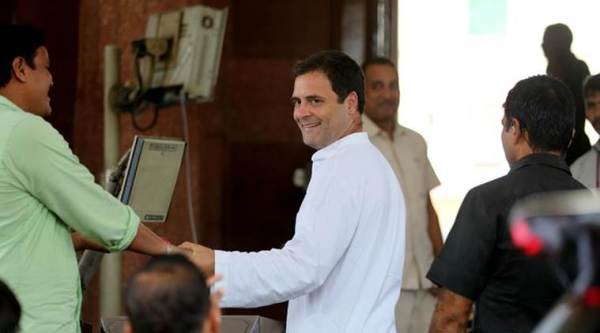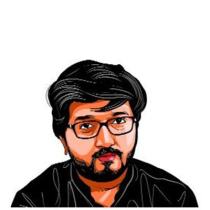Politics without close-ups
Visual vocabulary of no-confidence debate did not allow for larger-than-lifeness

Congress president Rahul Gandhi outside Parliament on Thursday (Express Photo/Tashi Tobgyal)
The debate preceding the vote on the no-confidence motion last week was viewed as Parliament sessions rarely are — as one friend put it, “haven’t binge-watched politics like this in ages”. But more than the result of the vote (a foregone conclusion), or perhaps even the words of the two main protagonists, it was the theatrics for a wide television audience that has had the greatest fallout. And for once, the seeming dullness of the way the camera captures legislative debates was used to great advantage by the underdog.
For the regular viewer — the kind who doesn’t read the credit roll with rapt attention — filmmakers have a simple trick to establish the hero: They take away the audience’s freedom. A close-up leaves us little choice, every calculated expression and gesture is plastered on the screen, and as we look on, only the well trained or the supremely disdainful are able to remain unaffected by this ruse. This basic principle of the visual medium, that the auteur controls what the people perceive and, therefore, can predict how they will react, has been used to great effect to curate a formidable image for the ruling party and its leader.
Speech after speech, in rallies and public addresses over the last four years, extols the achievements of the government, while denigrating its predecessors. As satellite television penetrates the hinterland, how these speeches have been framed visually has great bearing on how they shape the national discourse. The shot breakdown for the prime minister’s political speeches is not complicated, but it is appealing. A wide establishing shot shows us if there are any other junior functionaries on stage. From time to time, a jimmy jib (a long crane, remote controlled, that allows the camera to gain height) or a drone-mounted camera pans across to display the sea of saffron scarves that display support. Till the chants at the end, the PM with his skilled oratory, is all we see, in addition to mid-shots where the first few rows can be seen either listening with rapt attention or crying out in jubilation.
The newly-minted Congress president, by contrast, lacks metre and speaks in round-about ways of the high principles of India’s Constitution and the inclusiveness of his party. Unlike the BJP’s widely-telecast feed, the live footage of the Grand Old Party’s rallies show us the faces, sometimes bored, in the depths of a crowd; the sound quality is poor; the shots wide with frames that, like life, contain much that can distract from the main attraction.
In Parliament, unlike outside it, a PM truly is the first among equals. Perhaps the Speaker interrupts him less, just as the camera cuts away from his opponents just a bit more. The sheer analogue-ness of the telecast — the loose, static frames of multiple cameras, the unscripted interruptions, all the more jarring because the camera refused to capture them — would have made for a poor film. But in a political debate, they provided the Opposition an opportunity — a level playing field where the carefully crafted mass media machine of the BJP was neutralised. During the PM’s speech, there was no escaping the denigrating slogans of erstwhile allies, nowhere in the frame to hide the fact that two rows behind him, a party colleague constantly leaves his seat. Or a Union minister who looks pointedly at her watch. Or even the stoic un-reactions of a member of the margdarshak mandal. The angle of the camera when it frames him is such that it looks down, ever so slightly. This establishes, however subliminally, that no MP is greater than the institution.
The lack of creativity in the way the Parliament proceedings are broadcast brings into sharp relief the length and repetition in political speeches. In the Lok Sabha, there were no larger-than-life figures, just a motley group of men and women who collectively represent the will of the Indian people. Like us, they differed. And like in the real world, there was no way to ensure everyone listened to one’s point of view. The eye was certainly drawn to the PM’s laughter, and then his incredulity, at Rahul Gandhi’s speech and subsequent embrace. A wink did spark a debate, as did the mocking mimicking of an Italian accent.
But through it all, the viewing audience — the citizen — was not entrapped and then enamoured by the chains of a close-up.
aakash.joshi@expressindia.com
For all the latest Opinion News, download Indian Express App
More From Aakash Joshi
- Forwarded as Received: That’s a SportRahul baba may not be a good politician, but no matter, says WhatsApp uncle. His heart is in the right place...
- Forwarded as Received: For Whom the Boys TrollWhatsApp Uncle says the world isn’t a football field, and, when it comes to the nation, no one should be caught off-side ..
- Chetan Bhagat for the Pretentious SoulThe quaintness of middle-class British experience has come and gone with Hugh Grant. But, novelist Julian Barnes still seems to be stuck in it...







































No hay comentarios:
Publicar un comentario